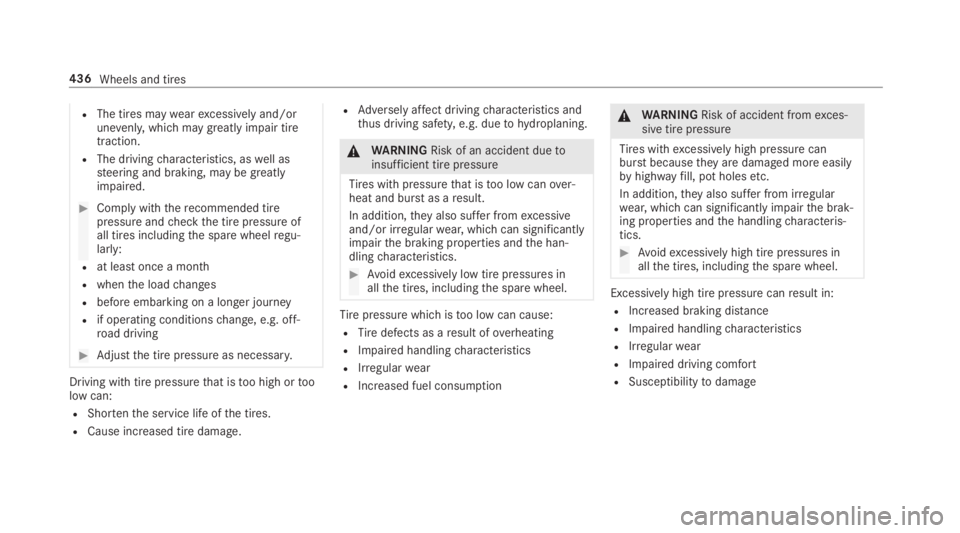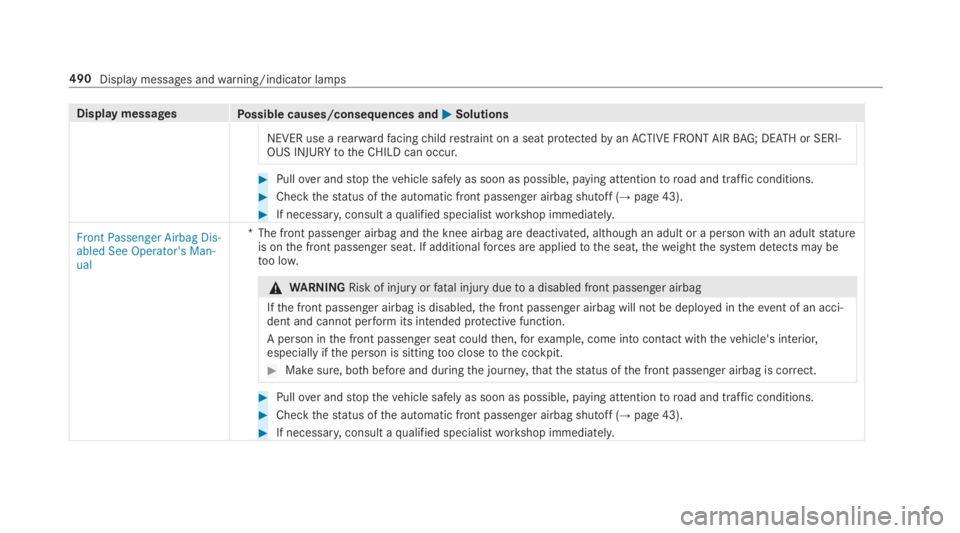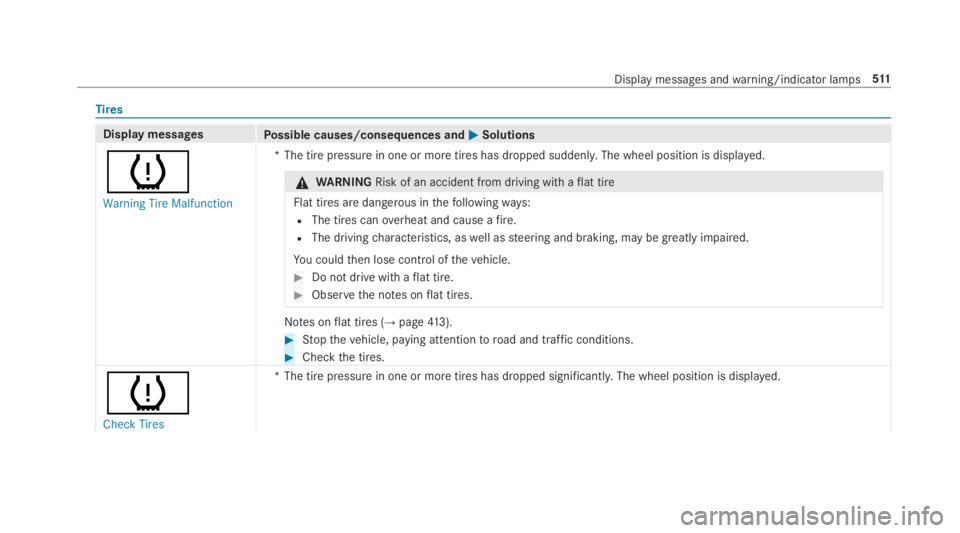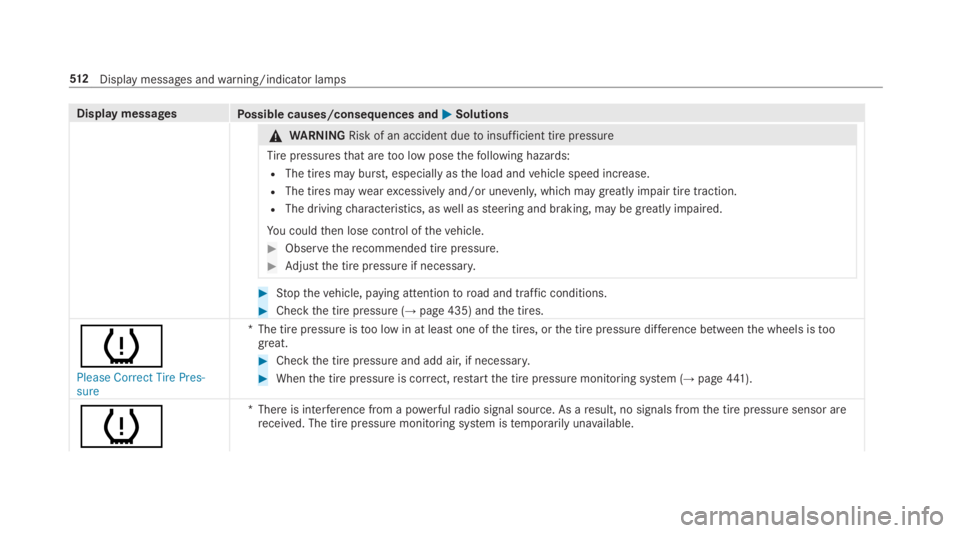2019 MERCEDES-BENZ S CLASS air condition
[x] Cancel search: air conditionPage 438 of 578

RThe tires maywearexcessively and/orunevenly,which maygreatlyimpair tiretraction.
RThe drivingcharacteristics, aswell assteering and braking, may be greatlyimpaired.
#Comply withtherecommended tirepressure andcheckthe tire pressure ofall tires includingthe spare wheelregu‐larly:
Rat least once a month
Rwhenthe loadchanges
Rbefore embarking on a longer journey
Rif operating conditionschange, e.g. off-road driving
#Adjustthe tire pressure as necessary.
Driving withtire pressurethat istoo high ortoolow can:
RShortenthe service life ofthe tires.
RCause increased tire damage.
RAdversely affect drivingcharacteristics andthus driving safety,e.g. dueto hydroplaning.
&WARNINGRisk of an accident duetoinsufficient tire pressure
Tires with pressurethat istoo low canover‐heat and burstas aresult.
In addition,theyalso suffer fromexcessiveand/or irregularwear, which can significantlyimpairthe braking properties andthe han‐dlingcharacteristics.
#Avoidexcessively low tire pressures inallthe tires, includingthe spare wheel.
Tirepressure which istoo low can cause:
RTiredefects as aresult ofoverheating
RImpaired handlingcharacteristics
RIrregularwear
RIncreased fuel consumption
&WARNINGRisk of accident fromexces‐sive tire pressure
Tires withexcessively high pressure canburst becausetheyare damaged more easilybyhighwayfill, pot holesetc.
In addition,theyalso suffer from irregularwear, which can significantly impairthe brak‐ing properties andthe handlingcharacteris‐tics.
#Avoidexcessively high tire pressures inallthe tires, includingthe spare wheel.
Excessively high tire pressure canresult in:
RIncreased braking distance
RImpaired handlingcharacteristics
RIrregularwear
RImpaired driving comfort
RSusceptibilitytodamage
436Wheels and tires
Page 440 of 578

The tire pressuretable shows therecommendedtire pressurefor all tires approvedforthisvehi‐cle. Therecommended tire pressures applyforcold tires undervarious operating conditions, i.e.loading and/or speed ofthevehicle.
If one or more tire sizes precede a tire pressure,the tire pressure informationfollowing is onlyvalidforthose tire sizes.
The load conditions "partially laden" and "fullyladen" are defined inthetablefor different num‐bersof passengers and amounts of luggage. Theactual number of seats may differ fromthis.
Some tire pressuretables only showtherimdiameter instead ofthe completetire size, e.g.R18. Therim diameter is part ofthe tire size andcan befound onthe tire sidewall (→page449).
Be suretoalso observethefollowing furtherrelated subjects:
RNotes on tire pressure (→page 435)
RTireand Loading Information placard(→page442)
RMaximum tire pressure (→page448)
Checkingtire pressures manually
#Readthe tire pressureforthe current operat‐ing conditions fromtheTireand LoadingInformation placard orthe tire pressuretable. Observethe notes on tire pressure.
#Removethevalve cap ofthe tiretobechecked.
#Pressthe tire pressuregauge securely ontothevalve.
#Readthe tire pressure.
#Ifthe tire pressure is lowerthantherecom‐mendedvalue, increasethe tire pressuretotherecommendedvalue.
#Ifthe tire pressure is higherthantherecom‐mendedvalue,release air.Todo so, pressdownthe metal pin inthevalve, e.g. usingthe tip of a penforexample. Thencheckthetire pressureagain usingthe tire pressuregauge.
#Screwthevalve cap ontothevalve.
438Wheels and tires
Page 454 of 578

UniformTireQuality GradingStandards:auniformstandardtogradethequality of tireswithregardtotreadquality,tire traction andtemperaturecharacteristics. Thequality gradingassessment is madebythe manufacturerfollow‐ing specifications fromtheU.S. government. Thequalitygrade of a tire is imprinted onthe sidewall ofthe tire.
Recommended tire pressure:therecommen‐ded tire pressure isthe tire pressure specifiedforthe tires mountedtothevehicle atthefac‐tory.
The tire and informationtable containstherec‐ommended tire pressuresfor cold tires,the max‐imum permissible load andthe maximum per‐missiblevehicle speed.
The tire pressuretable containstherecommen‐ded tire pressuresfor cold tires undervariousoperating conditions, i.e. loading and/or speedofthevehicle.
Increasedvehicleweight duetooptionalequipment:the combinedweight of allstandardand optional equipmentavailableforthevehicle,
regardless of whether it is actually installed onthevehicle or not.
Rim:the part ofthe wheel on whichthe tire isinstalled.
GAWR (Gross AxleWeightRating):the GAWRisthe maximum permissible axle load. Theactual load on an axle must neverexceedthegrossaxleweightrating. The gross axleweightrating can befound onthevehicle identificationplate onthe B‑pillar onthe driver's side.
Speedrating:the speedrating is partofthe tireidentification. It specifiesthe speedrangeforwhich a tire is approved.
GVW (GrossVehicleWeight):the grossvehicleweight comprisestheweight ofthevehicleincluding fuel,tools,the spare wheel, accesso‐ries installed, occupants, luggage andthe trailerdrawbar noseweight, if applicable. Thegrossvehicleweight must notexceedthe grossvehicleweightratingGVWR as specified onthevehicleidentification plate onthe B‑pillar onthe driver'sside.
GVWR (GrossVehicleWeightRating):theGVWR isthe maximum permitted grossweight
ofthe fully ladenvehicle (weight ofthevehicleincluding all accessories, occupants, fuel, lug‐gageandthe trailer drawbar noseweight if appli‐cable). Thegrossvehicleweightrating is speci‐fied onthevehicle identification plate ontheB‑pillar onthe driver's side.
Maximumweight ofthe ladenvehicle:themaximumweight isthe sum ofthe curbweightofthevehicle,theweight ofthe accessories,themaximum load andtheweight of optional equip‐ment installed atthefactory.
Kilopascal (kPa):metric unitfor tire pressure.6.9 kPa correspondsto1 psi. Another unitfortire pressureis bar.100 kilopascal (kPa) equals1 bar.
Load index:in additiontothe load-bearingindex,the load index may also be imprinted onthe sidewall ofthe tire. This specifiesthe load-bearing capacity ofthe tire more precisely.
Curbweight:theweight of avehicle withstand‐ard equipment includingthe maximum capacityof fuel, oil and coolant. It also includesthe airconditioning system and optional equipment if
452Wheels and tires
Page 486 of 578

Display messagesPossible causes/consequences and�P�PSolutions
#Havethe brake systemchecked immediately at aqualified specialistworkshop.
#Drive on carefully.
#Visit aqualified specialistworkshop immediately.
�'
(USA only)
�M
(Canada only)
Check Brake Fluid Level
*There is insufficient brakefluid inthe brakefluidreservoir.
&WARNINGRisk of an accident duetolow brakefluid level
Ifthe brakefluid level istoo low,the braking effect andthe brakingcharacteristics may be impaired.
#Pullover andstopthevehicle safely as soon as possible, paying attentiontoroad and traffic conditions.Do not continue driving under any circumstances.
#Consult aqualified specialistworkshop.
#Do not add brakefluid.
#Pullover andstopthevehicle safely as soon as possible, paying attentiontoroad and traffic conditions. Do notcontinue driving under any circumstances.
#Do not add brakefluid.
#Consult aqualified specialistworkshop.
Radar Sensors Dirty SeeOperator's Manual
*Theradar sensor system is malfunctioning.Possible causes are:
RDirt onthe sensors
RHeavyrain or snow
484Display messages andwarning/indicator lamps
Page 492 of 578

Display messagesPossible causes/consequences and�P�PSolutions
NEVER use arearwardfacingchildrestraint on a seat protectedbyanACTIVE FRONT AIRBAG; DEATH or SERI‐OUS INJURYtotheCHILD can occur.
#Pullover andstopthevehicle safely as soon as possible, paying attentiontoroad and traffic conditions.
#Checkthestatus ofthe automatic front passenger airbag shutoff (→page 43).
#If necessary,consult aqualified specialistworkshop immediately.
Front Passenger Airbag Dis-abled See Operator's Man-ual
*The front passenger airbag andthe knee airbag are deactivated, although an adult or a person with an adultstatureis onthe front passenger seat. If additionalforces are appliedtothe seat,theweightthe system detects may betoo low.
&WARNINGRisk of injuryorfatal injury duetoa disabled front passenger airbag
Ifthe front passenger airbag is disabled,the front passenger airbag will not be deployed intheevent of an acci‐dent and cannotperformits intended protective function.
A person inthe front passenger seat couldthen,forexample, come into contact with thevehicle's interior,especially ifthe person is sittingtoo closetothe cockpit.
#Make sure, bothbefore and duringthe journey,thatthestatus ofthe front passenger airbag is correct.
#Pullover andstopthevehicle safely as soon as possible, paying attentiontoroad and traffic conditions.
#Checkthestatus ofthe automatic front passenger airbag shutoff (→page 43).
#If necessary,consult aqualified specialistworkshop immediately.
490Display messages andwarning/indicator lamps
Page 499 of 578

Display messagesPossible causes/consequences and�P�PSolutions
Oncethe cause ofthe problem is no longer present, driving systems and driving safety systems will beavailableagain.
Ifthe display message does not disappear:
#Pullover andstopthevehicle safely as soon as possible, paying attentiontoroad and traffic conditions.
#Cleanthe windshield.
Active Lane Keeping AssistInoperative
*Active LaneKeeping Assist is malfunctioning.
#Consult aqualified specialistworkshop.
Malfunction Drive at Max.50 mph
*AIRMATIC is functioning onlytoa limitedextent. Thevehicle's handlingcharacteristics may be affected.
*NOTEThe tires ofthe front axle orthe frontfenderscould be damagedbylargesteering movements
#Avoid largesteering movements while driving and listenfor scraping sounds.
#Ifyou hear scraping sounds, pullover andstopthevehicle safely, paying attentiontoroad and traffic con‐ditions, and set a highervehicle level if possible.
#Drive in a manner appropriateforthe current level, but do notexceed 50mph (80 km/h).
#Visit aqualified specialistworkshop.Active Body Control is malfunctioning. Thevehicle's handlingcharacteristics may be affected.
*NOTEThe tires ofthe front axle orthe frontfenderscould be damagedbylargesteering movements
#Avoid largesteering movements while driving and listenfor scraping sounds.
Display messages andwarning/indicator lamps497
Page 513 of 578

Tires
Display messagesPossible causes/consequences and�P�PSolutions
�w
Warning Tire Malfunction
*The tire pressure in one or more tires has dropped suddenly. The wheel position is displayed.
&WARNINGRisk of an accident from driving withaflat tire
Flat tires are dangerous inthefollowingways:
RThe tires canoverheat and cause afire.
RThe drivingcharacteristics, aswell assteering and braking, may be greatly impaired.
You couldthen lose control ofthevehicle.
#Do not drive with aflat tire.
#Observethe notes onflat tires.
Notes onflat tires (→page413).
#Stopthevehicle, paying attentiontoroad and traffic conditions.
#Checkthe tires.
�w
Check Tires
*The tire pressure in one or more tires has dropped significantly.The wheel position is displayed.
Display messages andwarning/indicator lamps511
Page 514 of 578

Display messagesPossible causes/consequences and�P�PSolutions
&WARNINGRisk of an accident duetoinsufficient tire pressure
Tirepressuresthat aretoo low posethefollowing hazards:
RThe tires may burst, especially asthe load andvehicle speed increase.
RThe tires maywearexcessively and/or unevenly,which may greatly impair tire traction.
RThe drivingcharacteristics, aswell assteering and braking, may be greatly impaired.
You couldthen lose control ofthevehicle.
#Observetherecommended tire pressure.
#Adjustthe tire pressure if necessary.
#Stopthevehicle, paying attentiontoroad and traffic conditions.
#Checkthe tire pressure (→page 435) andthe tires.
�w
Please Correct Tire Pres-sure
*The tire pressure istoo low in at least one ofthe tires, orthe tire pressure difference betweenthe wheels istoogreat.
#Checkthe tire pressure and add air, if necessary.
#Whenthe tire pressure is correct,restartthe tire pressure monitoring system (→page441).
�w
*There is interference from a powerfulradio signal source. As aresult, no signals fromthe tire pressure sensor arereceived. The tire pressure monitoring system istemporarily unavailable.
512Displaymessages andwarning/indicator lamps